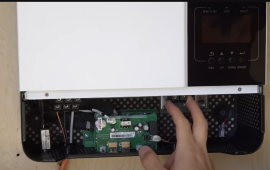12VoltInstalls
life passes by too quickly to not live in freedom
That’s rated for 25- or 30A?plan to connect a GE surge protector outlet
That’s rated for 25- or 30A?plan to connect a GE surge protector outlet
10ga to a breaker panel/sub-box. Appropriate-sized wire to whatever outlets you require. That’s what I would do. 3000W is ~25A nominal at ~120VAC.
10ga is 30A, 12ga is 20A, 14ga is 15A, 16ga should be left at the store.
Why?!?not doing a break panel/sub-box.
Literally no idea how to do that one. I'm a complete newbie.10 gage wire / cable
Why?!?
What are you splicing? The 10ga cord (which may only be rated at 20A or 15A due to sheathing materials used and/or the moulded plug end) would go into the growatt’s terminals for AC out, and the tesla NEMA plug would plug into that. No splicing involved.Just splice that into the three colors and put into the AC output, right?
Yes. Technically, if I understand correctly, I believe the growwhat has a fuse within it - or a pop out breaker- notwithstanding it will shut down on overload if it exceeds its rating of 3000W
so if the grwatt is not being used for any other purpose you could connect directly into the AC with an extension cord that is sufficient to handle the maximum output amps from the inverter (10ga) and if the Tesla draws the stated 20A it should work.
(Ignoring any grounding issues or absence of a breaker or GFCI)
Not how i would do it but I’m funny/particular about some things.
You mean strip the external jacket I’m understanding now. Stripping; splicing is connecting wires or ropes together.splice it into the three colors
Oops. Typical. I meant "slice".You mean strip the external jacket I’m understanding now. Stripping; splicing is connecting wires or ropes together.

You suggested I get a 10ga, which I am assuming is the same as a 10/3, that would handle 30a.
Am I missing anything?
OR it could aluminumThe 10ga cord (which may only be rated at 20A or 15A due to sheathing materials used and/or the moulded plug end)
47V is very low for four panels in series. Sounds more like 2S2P, unless they were part of a circuit with a battery or PWM controller or whatever.Question for anyone who can help.
I gave my PIP 2724LV-MR 24 inverter to my father.
The batteries powered the unit up, but it doesn't detect the solar panels.
He has 4 x 100w solar panels in series.
I tested the MC4 connectors, and it shows 47v. When I connect the MC4 to the inverter, it doesn't show any v or watts.
While connected to the SCC?tested the MC4 connectors, and it shows 47v
=====Even more problematic: my teacher salary has me cuffed to about 1k

=====
Edit: I did not realize we were seven pages into the thread when I posted this after only reading post 1.?
======
Impossible. Don’t take it as a challenge.
Here are my experiences level 1 charging a Tesla.

Level 1Charging a Tesla Model 3 off grid
I did level 1 charging with my Tesla model 3 with my solar setup, and these are the results: 4.33 miles / hour charged 322 wh/mile from the ac inverter 367 wh/mile from the Batteries to cover AC losses AC draw from inverter while charging 1400 watts +/-2watts. AC Draw from inverter before...diysolarforum.com
To see my system, look in my signature block in Rv build part 1 and part 2.
As an aside, I taught 5th 6th grade for two years. I have been much happier since I changed jobs.


